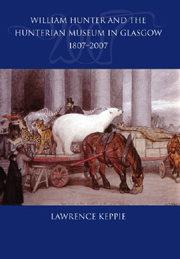Book contents
- Frontmatter
- Contents
- Foreword by Sir Kenneth Calman
- Introduction
- List of Illustrations
- Acknowledgements
- Abbreviations used in the Notes
- Dedication
- 1 William Hunter's Life and Career
- 2 Growth of the Hunterian Collection
- 3 ‘The Noblest Legacy upon Record’
- 4 A Temple of the Muses: the First Hunterian Museum in Glasgow
- 5 ‘This Place of Fascination’: the Impact of the Museum, 1807–70
- 6 A New Museum for a New University, 1870–1900
- 7 The Twentieth Century: War, Peace and Renewal, 1900–75
- 8 The Hunterian Art Gallery
- 9 Modern Times, 1975–2007
- 10 Overview: Meeting William Hunter's Intentions
- Postscript: Looking to the Future
- Notes
- Appendix: Catalogues of the Hunterian Collections
- Bibliography
- Index
- Plate section
2 - Growth of the Hunterian Collection
Published online by Cambridge University Press: 12 September 2012
- Frontmatter
- Contents
- Foreword by Sir Kenneth Calman
- Introduction
- List of Illustrations
- Acknowledgements
- Abbreviations used in the Notes
- Dedication
- 1 William Hunter's Life and Career
- 2 Growth of the Hunterian Collection
- 3 ‘The Noblest Legacy upon Record’
- 4 A Temple of the Muses: the First Hunterian Museum in Glasgow
- 5 ‘This Place of Fascination’: the Impact of the Museum, 1807–70
- 6 A New Museum for a New University, 1870–1900
- 7 The Twentieth Century: War, Peace and Renewal, 1900–75
- 8 The Hunterian Art Gallery
- 9 Modern Times, 1975–2007
- 10 Overview: Meeting William Hunter's Intentions
- Postscript: Looking to the Future
- Notes
- Appendix: Catalogues of the Hunterian Collections
- Bibliography
- Index
- Plate section
Summary
‘Collecting in the largest sense of the word’
This was an era of expansive collecting, and acquisitiveness, both by individuáis and by institutions such as the Royal Society. The enormous holdings accumulated in London by the physician Sir Hans Sloane covered subject areas represented, though on a smaller scale, in William's museum; they were to form the basis of the British Museum, founded in 1753. King George III and his wife, Queen Charlotte, collected widely in many fields, including the decorative arts. Many others, including medical men such as Richard Mead, were active collectors. Some made their museums accessible to the public, for an admission fee.
William began to accumulate anatomical preparations at an early stage in his teaching career in London. Already, in 1742, he had acquired Dr James Douglas' anatomical preparations when the latter died. In 1754–5, at the sale of the collection of Dr Richard Mead, he bought numerous books, some paintings of famous medical predecessors, and an Egyptian mummy which cost him 13 guineas.
After he moved to Great Windmill Street in 1767 William diversified his collecting activities, adding fossils and minerals, more paintings and, from around 1770, coins and medals, the latter at first for pleasure. ‘At the moment I am sinking money so fast’, he wrote to Cullen in 1768, ‘that I am rather embarrassed. I am now collecting in the largest sense of the word.’
- Type
- Chapter
- Information
- Publisher: Edinburgh University PressPrint publication year: 2007

